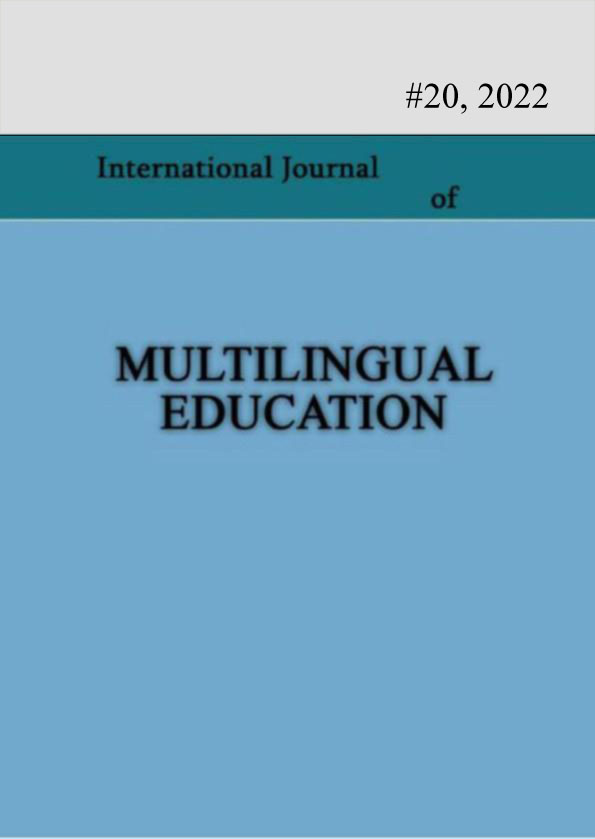Practices of Submersion Education and Readiness of Teachers to Teach in a Culturally Diverse Classroom on the Case of Georgia
Keywords:
Classroom environment, Multilingual, Expectations, Different language, Intercultural sensitivityAbstract
In this article will be introduced the teaching practice and challenges for one of the most popular education programs in Georgia, the Submersion Bilingual Program. The practice of submersion bilingual education includes the learning and teaching process of linguistic majority and minority students together, in the same classroom environment, with the same curriculum in the majority language. The existence of a submersion bilingual program in Georgia is conditioned by the ethnic and linguistic diversity of the country's population. The article is based on a qualitative research in which I studied the attitudes of teachers in submersion schools and their professional readiness to teach in a multilingual classroom. The research analyzes the difference between teachers' expectations towards minority and majority students and the impact of teachers' attitudes and preconceptions on the process of forming expectations towards ethnic students. The article below also highlights the challenges specific to submersion schools, the
methodological knowledge and intercultural skills of teachers, and their practices for effective teaching in a different language environment. At the end of the article the author's conclusions and recommendations are provided which are based on the research findings in order to improve teaching practice.
References
Baker, C. (2006/2010). Foundations of Bilingual Education and Bilingualism (S. Tabatadze, Trans.) Multilingual Matters. (Original work published 2006).
Collier, V. P. (1995). Acquiring a second language for school. Directions in language and education, 1(4), 2-14.
Cummins, J. (1981). The role of primary language development in promoting educational success for language minority students. In California State Department of Education (ed.), Schooling and language minority students: A theoretical framework. Los Angeles: Evaluation, Dissemination and Assessment Center California State University, 3- 49.
Department of Education and Training (Victoria) and Victorian Curriculum and Assessment Authority (2016). Victorian Early Years Learning and Development Framework. Melbourne: Department of Education and Training (Victoria).
National Statistics Office of Georgia. (2019). Demographic Situation in Georgia 2019. Tbilisi, Georgia.
Tabatadze, S. (2010). Bilingual education programs in Georgia, what public schools can choose. Journal Bilingual Education, 1, 7-21.
Tago, M., & Ots, A. (2010). Pupils who speak a „wrong” language: Bilingual children’s academic achievement in submersion education. In A. Toomela (Ed.), Systemic person- oriented study of child development in early primary school (pp. 133–154). Frankfurt am Main: Peter Lang.
Timmermans, A. C., & Rubie-Davies, C. M. (2018). Do teachers differ in the level of expectations or in the extent to which they differentiate in expectations? Relations between teacher-level expectations, teacher background and beliefs, and subsequent student performance. Educational Research and Evaluation, 24 (3- 5), 241-263.
Trinidad, J. E. (2019). Collective expectations protecting and preventing academic achievement. Education and Urban Society, 51(9), 1147-1171, doi:10.1177/0013124518785444.
Valdés, G. (2001). Learning and not learning English: Latino students in American schools. New York: Teachers College Press.
Valdés, G. (2004). Between support and marginalisation: The development of academic language in linguistic minority children. International Journal of Bilingual Education and Bilingualism, 7(2-3), 102-132, doi: 10.1080/13670050408667804
Published
How to Cite
Issue
Section
License
Copyright (c) 2022 Lena (Elene) Jajanidze

This work is licensed under a Creative Commons Attribution-NonCommercial 4.0 International License.
Copyright (c) - Authors who publish with this journal agree to the following terms: Authors retain copyright and grant the journal the right of first publication with the work simultaneously licensed under a Creative Commons Attribution-Noncommercial 4.0 International License, which allows others to share the work with an acknowledgement of the work's authorship and initial publication in this journal. Authors are permitted and encouraged to post their work online (e.g., in institutional repositories or on their personal website) prior to and during the submission process, as it can lead to productive exchanges, as well as earlier and greater citation of published work (see The Effect of Open Access). Authors may enter into separate, additional contractual arrangements for the non-exclusive distribution of the journal's published version of the work (e.g., post it to a repository or publish it in a book), with an acknowledgement of its initial publication in this journal.

